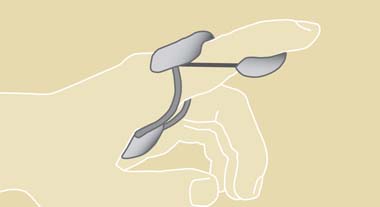The hand and fingers seem to work effortlessly when healthy. Normal joints have considerable motion, enabling us to perform many different activities with our hands for work, leisure, communication, and more. A variety of problems can cause stiffness in the hand, limiting the use and function that we often take for granted.
How do joints move?
Joints have precisely shaped matching surfaces that are covered with a smooth layer of cartilage, like ball bearings, to allow considerable motion. Ligaments are fibrous structures that hold the bones together on each side of the joint, like stout pieces of tape. They are shaped and located in such a way that they permit motion while stabilizing the joint. The volar plate protects the joint from hyperextension (bending back too far), and the collateral ligaments provide stability against side-to-side stress. Capsule is a thinner lining that encloses the joint. Muscles provide the power and movement to generate motion, and tendons are like cables that transmit this movement from the muscles to the joints (see Figure 1).
Why do joints get stiff?
Problems that affect these structures can result in stiffness. Various types of arthritis can distort the contour of a joint, altering its geometry so that it can’t move normally. Fractures can also distort the smooth surface of a joint. Fractures that aren’t even in the joint can cause adherence of nearby structures, such as tendons and muscles. Scarring at the site of fracture healing can tether these structures and limit their motion, resulting in stiffness. Dislocations and even bad sprains can injure the ligaments and capsule, causing them to become thicker and less elastic with consequent loss of mobility. Tendon and muscle injuries can also cause them to get scarred down to their surroundings and thus lose some of their usual mobility, resulting in stiffness.
How is stiffness evaluated?
Your doctor will need to know about the onset and progression of the stiffness, its effect on use of the hand, any injuries, other medical conditions, and any prior treatment. Careful examination is performed to check the range of motion, noting any difference between the active motion (motion that you can generate on your own power) as opposed to passive motion (motion that results from external force). Swelling and tenderness are assessed, as well as any differences in mobility that may vary depending on the position of neighboring joints. The muscles and tendons are also evaluated for their action and any tightness. It is also very important to assess the impact of stiffness on function.
X-rays are usually obtained to evaluate for arthritis and any other distortion of the bones and joints. On occasion, other studies may be considered, such as MRI or CT scan, for special situations which can not be adequately assessed by X-rays.
How is stiffness treated?
Conservative treatment may include stretching exercises for the joints and muscles, as well as modalities to help loosen them. Different types of splints or casts may be used to try to provide sustained force to stretch the tight joints and regain more motion (see Figures 2, 3). Such measures are often performed under the care of a hand therapist.
Surgery may need to be considered if conservative treatment is not working. Surgery can include releasing the tight ligaments and capsule and/or freeing up adherent tendons and muscles. Such procedures usually require intensive post-op hand therapy in order to maintain the gains achieved at surgery, and the patient must be ready to commit to such a program. Otherwise, the structures that were released are likely to scar down again, resulting in recurrent or worsened stiffness.
If the stiffness is from arthritis, aggressive stretching and surgical releases are usually not advised as the contour of the joint may be too distorted for these approaches to work. Adaptive strategies in the way the hand is used may be helpful. Joint replacement or reconstruction may need to be considered. Pain and functional impairment are the main reasons to consider surgery. Not all stiff joints need intervention. For example, the end joint (distal interphalangeal, or DIP) of the finger can be stiff but still compatible with good finger function. Sometimes joints are even surgically fused in order to relieve pain and/or put the finger in a more functional alignment.
Your hand surgeon will help you decide the best approach to take for your individual situation. Successful outcomes depend on the combined efforts of the surgeon, therapist, and patient.
Figure 1
Figure 2
Figure 3



